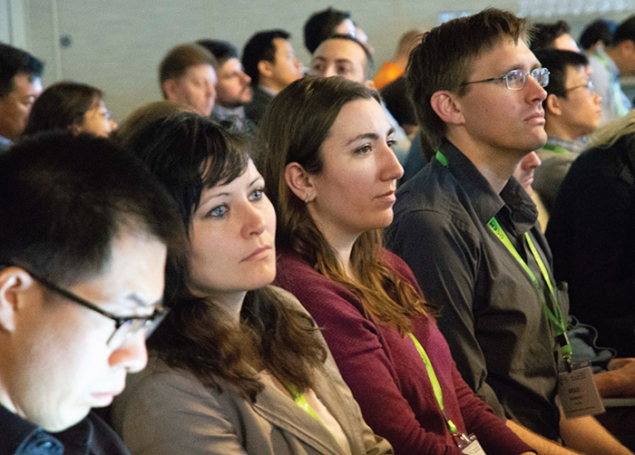
The 9th International Particle Accelerator Conference (IPAC18) was held in Vancouver, Canada, from 29 April to 4 May. Hosted by TRIUMF and jointly sponsored by the IEEE Nuclear and Plasma Sciences Society and the APS Division of Physics of Beams, the event attracted more than 1210 delegates from 31 countries, plus 80 industry exhibits staff. The scientific programme included 63 invited talks and 62 contributed orals, organised according to eight main classes. While impossible to summarise the full programme in a short article, below are some of the highlights from IPAC18 that demonstrate the breadth and vibrancy of the accelerator field at this time.
A foray into the future of accelerators by Stephen Brooks of Brookhaven National Laboratory was a walk on the wild side. The idea of a single-particle collider was presented as a possibility to achieve diffraction-limited TeV beams to bridge the potential “energy desert” between current technology and the next energy regime of interest. Relevant technological and theoretical challenges were discussed, including multiple ideas for overcoming emittance growth from synchrotron radiation, focusing beams (via gravitational lensing!) and obtaining nucleus-level alignment, as was how to reduce the cost of future accelerators.
The rise of X-ray free-electron lasers in the past decade, opening new scientific avenues in areas highly related to wider society, was a strong theme of the conference. In addition, in the session devoted to photon sources and electron accelerators, Michael Spata described the Jefferson Laboratory’s 12 GeV upgrade of CEBAF, which began full-power operation in April after overcoming numerous challenges (including installation and operation of a new 4 kW helium liquefier, and field-emission limitations in the cryomodules). James Rosenzweig (UCLA) described progress towards an all-optical “fifth-generation” light source. Here, a TW laser pulse would be split into two, with half being used to accelerate high-quality electron bunches as they co-propagate in a tapered undulator, and the other half striking the accelerated electron beam head on so that the back-scattered photons are shifted to much shorter wavelengths. The scheme could lead to a compact, tunable multi-MeV gamma-ray source, and successful demonstrations have already taken place at the RUBICONICS test stand at UCLA.
Concerning novel particle sources and acceleration techniques, plasma-wakefield acceleration featured large. CERN’s Marlene Turner described progress at the AWAKE experiment, which aims to use a high-energy proton beam to generate a plasma wake that is then used to accelerate an electron beam. Last year, the AWAKE team demonstrated self-modulation of the proton beam and measured the formation of the plasma wakefield. Now the team has installed the equipment to test the acceleration of an injected electron beam, which is expected to be completed in 2018. Felicie Albert of Lawrence Livermore National Laboratory also described the use of laser-wakefield technology to generate betatron X rays, which could enable new measurements at X-ray free-electron lasers.
With IPAC18 coinciding with TRIUMF’s 50th anniversary (CERN Courier May 2018 p31), laboratory director Jonathan Bagger described the evolution of TRIUMF from its founding in 1968 by three local universities to the present-day set-up with 20 member universities, users drawn from 38 countries and an annual budget of CA$100 million. Also in the hadron-accelerator session was a talk by Sergei Nagaitsev of Fermilab about the path to the Long-Baseline Neutrino Facility, which is actually three parallel paths: one for the proton beams (PIP-II), one for the detector which will be located in the Homestake mine in South Dakota (DUNE) 1300 km away, and one for the facilities at Fermilab and Homestake. The three projects will engage more than 175 institutions from around the world with the aim of investigating leptonic CP violation and the mass hierarchy in the neutrino sector. The International Facility for Antiproton and Ion Research (FAIR) under construction in Germany (CERN Courier July/August 2007 p4) was another focus of this session, with Mei Bai of GSI Darmstadt summarising the significant upgrade of the heavy-ion synchrotron SIS18 that will drive the world’s most intense uranium beams for future FAIR operation.
In the session devoted to beam dynamics and electromagnetic fields, Valery Telnov (Budker Institute) introduced a cautionary note about bremsstrahlung at the interaction points of future electron–positron colliders (such as FCC-ee) that will impact beam lifetimes whereas present-generation colliders (such as SuperKEKB) are dominated by synchrotron radiation in the arcs. Tessa Charles of the University of Melbourne, meanwhile, introduced the method of “caustics” to understand and optimise longitudinal beam-dynamics problems, such as how to minimise coherent synchrotron radiation effects in recirculation arcs.
The proton linac for the European Spallation Source (ESS) under construction in Sweden was presented by Morten Jensen during the session on accelerator technology. He outlined the variety of radio-frequency (RF) power sources used in the ESS proton linac and the development of the first-ever MW-class “inductive out tubes” for the linac’s high-beta cavities, which have been tested at CERN and reached record-beating performances of 1.2 MW output for 8.3 kW input power. Pending the development of a production series, the accelerator community may have a new RF workhorse.
As indicated, these are just a few of the many scientific highlights from IPAC18. Industry was also a major presence. In an industry panel discussion, speakers talked about successful models for technology transfer, while talks such as that from Will Kleeven (IBA) described the Rhodotron compact industrial CW electron accelerator producing intense beams with energies in the range from around 1 to 10 MeV, which has key industry applications including polymer cross-linking, sterilisation, food treatment and container security scanning.
IPAC is committed to welcoming young researchers, offering more than 100 student grants and heavily discounted fees for all students. Almost 1500 posters were presented by authors from 233 institutions over four days. The regional attendance distribution was 24% from Asia, 41% from Europe and 35% from the Americas, demonstrating the truly international nature of our field. The 10th IPAC will take place in Melbourne, Australia, on 19–24 May 2019.








